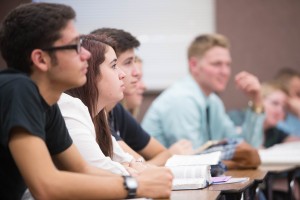
New, more strict requirements for seminary graduation will better prepare high school students to hasten the work and serve missions younger.
“We’re going to see a generation of seminary students who are heading into the mission field better doctrinally prepared,” said BYU religion professor Anthony R. Sweat, a former seminary teacher.
In addition to the attendance policy, which requires 75 percent attendance, seminary students who want to officially graduate must now pass two learning assessments per year with a score of 75 percent or higher and read each school year’s assigned book of scripture.
“It’s obviously not new that we want the students to read the text and learn the doctrine,” said Eric Wing, principal of Provo High School Seminary. “All of this is just intended to enhance what the students are gaining from seminary.”
Although the change surprises some, students themselves don’t recognize much of a difference. Provo High School students’ response was one of indifference when Wing presented them with the new requirements on the first day of school.
“They looked at me like, ‘Well, duh … isn’t that what we’ve always done?'” Wing said. “They didn’t seem concerned, for one, but they didn’t even seem like it was noteworthy.”
Sweat said the change has been a decade in coming and is designed to better prepare students for missionary service.
“A number of years ago they started emphasizing 10 core basic doctrines,” Sweat said. “These are the core things that missionaries need to know when they end up using Preach My Gospel, and so we need to emphasize these better in seminary.”
Seminary teachers and leaders have recognized the greater responsibility they have to train future missionaries, since the change in missionary ages results in less time to prepare for a mission after graduating from high school.
“It just speaks to the confidence that the Brethren have in our students, and how they view the students as far as what they will need in order to be successful in the hastening of the work,” said Sean Dixon, Utah Valley South Area director for seminaries and institutes.
As for the prospect of a drop in number of seminary graduates, leaders anticipate that figure to be close to zero.
“President Monson has asked that we not lose one student over this,” Dixon said. “He made strong emphasis that we want to elevate learning, but we don’t want to lose one student.”
Sweat didn’t believe this would be much of a problem at all.
“The students are more than capable, but because they’ve elevated the expectation, we’re going to see an elevation in student performance,” he said. “People in general rise to the level of what’s expected of them.”
For one thing, students who fail to complete the reading or learning assessment requirements but who still fulfill the attendance obligation will receive a certificate of recognition, just as they always have. Students will also have multiple opportunities to retake the assessment.
“We expect that all the students will pass the test; it just may take a little more time and effort to make it happen,” Dixon said.
Students will also have the chance to make up for missed attendance and reading.
Everyone believes that these changes will only increase the knowledge and spiritual preparation of seminary graduates.
“This emphasis, this focus, these changes, it’s all intended to help increase the ability of the students to follow the Savior,” Wing said.




